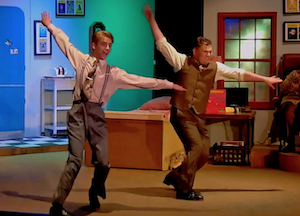For a musical whose leading character begins the show with the words “I hate theatre,” Cambria Center for the Arts’ production of The Drowsy Chaperone gives us a whole lot of reasons to take the opposite view.
One: Where else are you likely to see a blindfolded bridegroom on roller skates who also sings and dances?
Two: Where else could you encounter 1920’s-style gangsters who disguise themselves as pastry chefs wearing spats?
Three: Where else could you spend two hours in person with a dizzy group of singers, dancers, actors and creative types who want only to entertain you with fabulous costumes, zany choreography, and great vocal skills?
. . . it gives talented performers and designers a showcase that reminds us of the wealth of talent all around us on the Central Coast.”
These reasons and others are why I love live theatre. There’s nothing more magical than seeing a local production that takes a show like The Drowsy Chaperone and makes it something everyone should experience. Admittedly, the material isn’t the best in the world—written in 1998 with a Broadway run in 2006-2007, it isn’t performed that often now and the musical numbers aren’t particularly memorable—but it gives talented performers and designers a showcase that reminds us of the wealth of talent all around us on the Central Coast.
 The show is structured around a character, Man in Chair (Hank Wethington, fitting the role perfectly), who treats us to his take on a fictional 1928 musical comedy, The Drowsy Chaperone, which he presents to us as the epitome of what theatre used to be. “Oh how things have changed,” he addresses the audience directly, admitting that when he’s feeling anxious, blue, or sad, it’s this show that makes him happy.
The show is structured around a character, Man in Chair (Hank Wethington, fitting the role perfectly), who treats us to his take on a fictional 1928 musical comedy, The Drowsy Chaperone, which he presents to us as the epitome of what theatre used to be. “Oh how things have changed,” he addresses the audience directly, admitting that when he’s feeling anxious, blue, or sad, it’s this show that makes him happy.
It makes us happy, too. No need to go into the plot or specific characters, all of which are generic vehicles out of which director Dakota W. Simpson and choreographer Parker Lowrie create theatre magic. Zippy dance numbers include some great tap dancing by Jordan Herman (as the afore-mentioned bridegroom) and Parker Lowrie (as his best man). Fabulous costumes by Karen Russu remind us of the glitter and glamor of the roaring ‘20s, with multiple costume changes featuring beads and fringes and double-breasted suits (not to mention those spats).
If there’s a groom there must be a bride, and Emy Herman emotes, and sings, and dances, and wears fabulous fashions, and all in all makes you believe she’s supposed to be a Broadway star who is considering giving it all up for her man (remember, it’s the 1920s).
It does what a musical is supposed to do: it takes you to another world.”
There’s witty repartee, with Sarah Raines as The Chaperone and Dakota Simpson as Adolpho leading the pack with their droll badinage. Simpson is particularly good at chewing the scenery—but it’s okay because it’s all in the script. There’s comedic clumsiness and character-driven pratfalls (Andrew Orr’s Underling springs immediately to mind). There are spit-takes and more spit-takes.
There’s an understudy (a delicious Carlie Herman) who reads minds (conveniently); a producer (Cory James Stoppel) who’s in hot water (but aren’t they all?); the afore-mentioned gangsters (Angus McNellie and Diego Porras, who make a delightful pair of rogues); and Mrs. Tottendale (Quinlin Gallagher, who plays ditzy charmingly), whose only function seems to be to be ditzy.
When the ensemble breaks into the final crowd-pleasing production number, we can’t help but agree with Man in Chair’s final assessment: “It does what a musical is supposed to do: it takes you to another world.”
So, so true.
